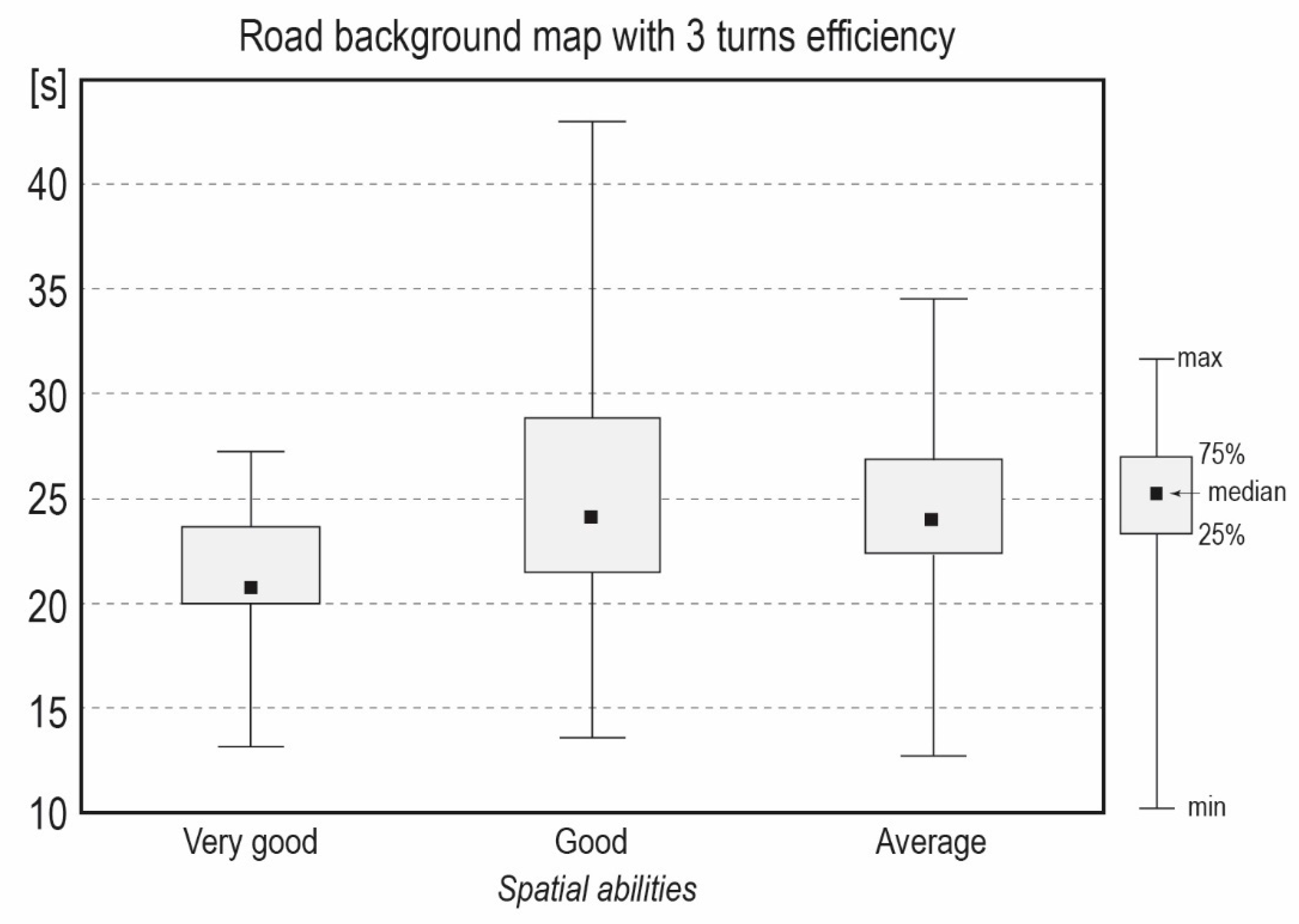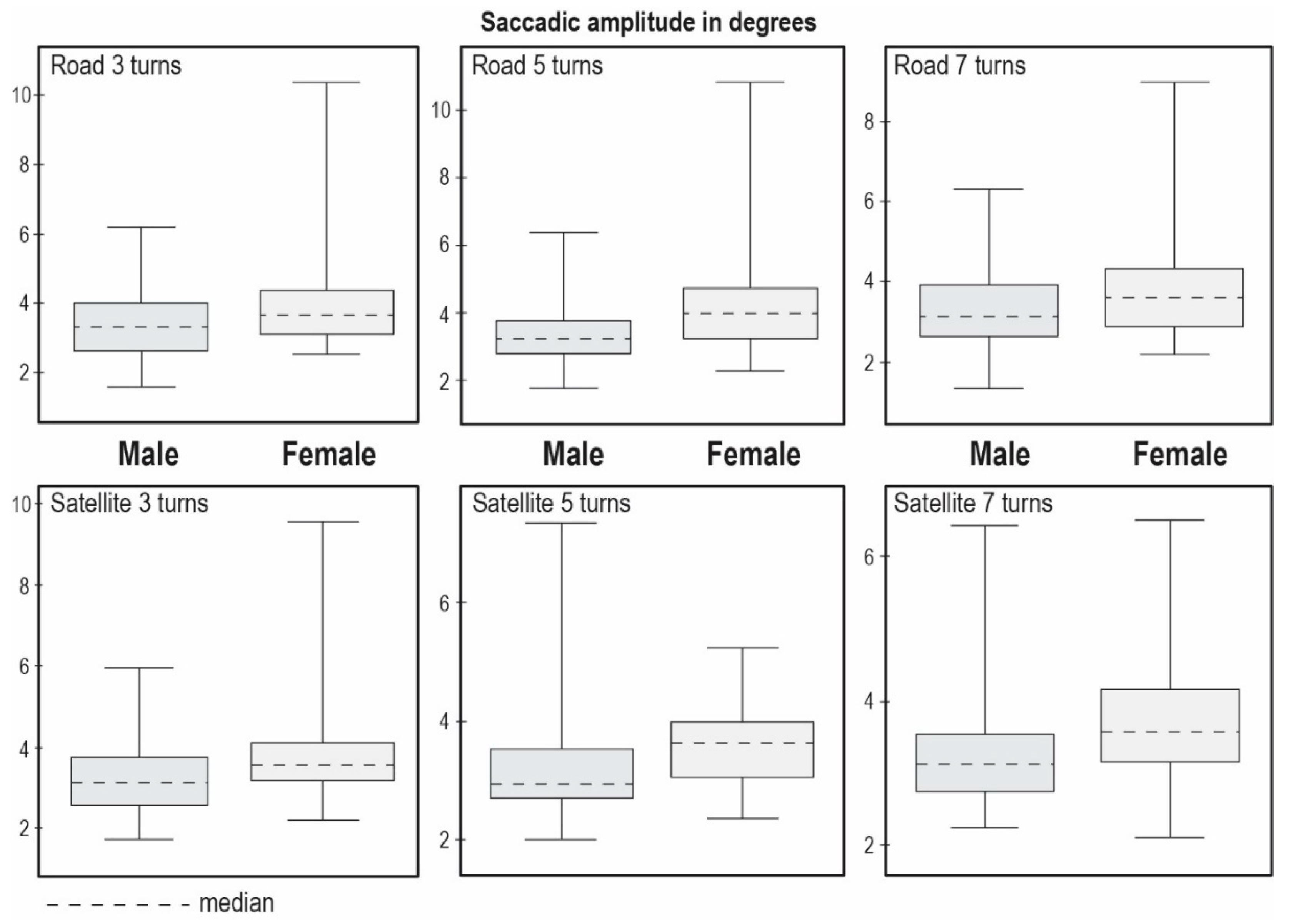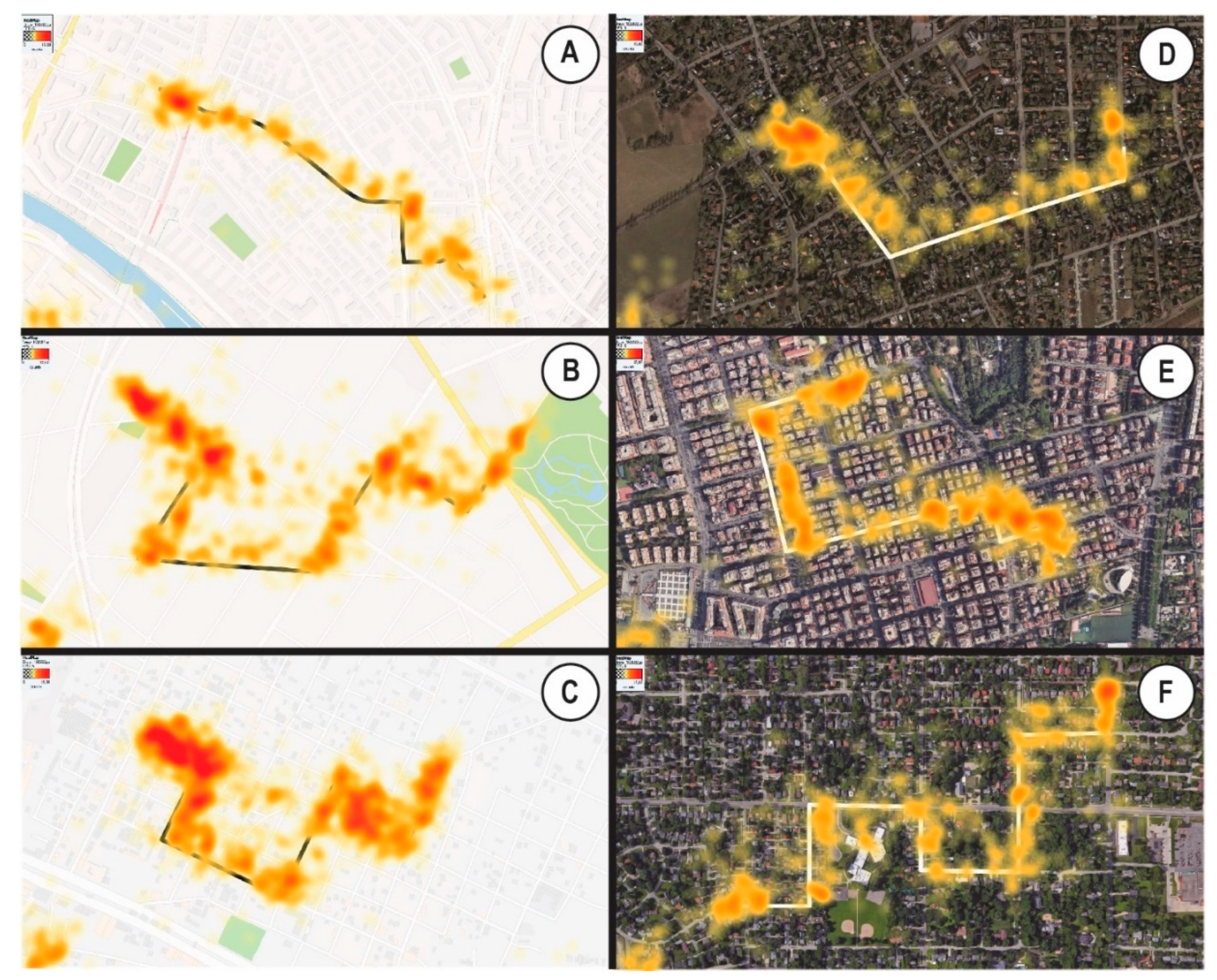Effectiveness of Memorizing an Animated Route—Comparing Satellite and Road Map Differences in the Eye-Tracking Study
Abstract
:1. Introduction
2. Related Research
3. Methodology
3.1. Animated Route Maps
3.2. Experimental Procedure
3.3. Participants
3.4. Effectiveness and Efficiency Evaluation
3.5. Eye movement Metrics
4. Results
4.1. Effectiveness and Efficiency Analysis
4.2. Eye Movement Analysis
5. Discussion
6. Conclusions
Funding
Data Availability Statement
Acknowledgments
Conflicts of Interest
References
- DiBiase, D.; MacEachern, A.M.; Krygier, J.B.; Reeves, C. Animation and the role of map design in scientific visualization. Cartogr. Geogr. Inf. Syst. 1992, 19, 201–214. [Google Scholar] [CrossRef]
- Andrienko, G.; Andrienko, N.; Demsar, U.; Dransch, D.; Dykes, J.; Fabrikant, S.I.; Jern, M.; Kraak, M.-J.; Schumann, H.; Tominski, C. Space, time and visual analytics. Int. J. Geogr. Inf. Sci. 2010, 24, 1577–1600. [Google Scholar] [CrossRef] [Green Version]
- Maggi, S.; Fabrikant, S.I.; Imbert, J.-P.; Hurter, C. How do display design and user characteristics matter in animations? An empirical study with air traffic control displays. Cartogr. Int. J. Geogr. Inf. Geovis. 2016, 51, 25–37. [Google Scholar] [CrossRef]
- See, L.-C.; Chang, Y.-H.; Chuang, K.-L.; Lai, H.-R.; Peng, P.-I.; Jean, W.-C.; Wang, C.-H. Animation program used to encourage patients or family members to take an active role for eliminating wrong-site, wrong-person, wrong-procedure surgeries: Preliminary evaluation. Int. J. Surg. 2011, 9, 241–247. [Google Scholar] [CrossRef] [PubMed] [Green Version]
- Edler, D.; Dickmann, F. The Impact of 1980s and 1990s Video Games on Multimedia Cartography. Cartogr. Int. J. Geogr. Inf. Geovis. 2017, 52, 168–177. [Google Scholar] [CrossRef]
- Medyńska-Gulij, B.; Zagata, K. Expert and Gamers on Immersion into Reconstructed Strongholds. ISPRS Int. J. Geoinf. 2020, 9, 655. [Google Scholar] [CrossRef]
- Spallone, R. In the Space and in the Time. Representing Architectural Ideas by Digital Animation. In Proceedings of the International and Interdisciplinary Conference IMMAGINI, Brixen, Italy, 27–28 November 2017; Volume 1, pp. 27–28, 962. [Google Scholar] [CrossRef] [Green Version]
- Harrower, M. The Cognitive Limits of Animated Maps. Cartogr. Int. J. Geogr. Inf. Geovis. 2007, 42, 349–357. [Google Scholar] [CrossRef]
- Vozenilek, V.; Kralik, T. Anaglyph videoanimations from oblique stereoimages. In Proceedings of the Sixth International Conference on Graphic and Image Processing 2015, China, Beijing, 24–26 October 2014. [Google Scholar] [CrossRef]
- Garlandini, S.; Fabrikant, S.I. Evaluating the effectiveness and efficiency of visual variables for geographic information visualization. In Spatial Information Theory. COSIT 2009, Aber Wrac’h, France, 21–25 September 2009; Horsby, K.S., Clarmunt, C., Denis, M., Ligozat, G., Eds.; Springer: Berlin/Heidelberg, Germany, 2009; pp. 195–211. [Google Scholar]
- Miller, G The Magical Number Seven, Plus or Minus Two: Some Limits on Our Capacity for Processing Information. Psychol. Rev. 1956, 63, 81–97. [CrossRef] [Green Version]
- Farrell, M.J.; Arnold, P.; Pettifer, S.; Adams, J.; Graham, T.; MacManamon, M. Transfer of route learning from virtual to real environments. J. Exp. Psychol. Appl. 2003, 9, 219–227. [Google Scholar] [CrossRef]
- Klippel, A.; Tappe, H.; Habel, C. Pictorial representations of routes: Chunking route segments during comprehension. In Spatial Cognition; Freksa, C., Brauer, W., Habel, C., Wender, K., Eds.; Springer: Berlin/Heidelberg, Germany, 2002; pp. 11–33. [Google Scholar] [CrossRef]
- Midtbø, T.; Larsen, E. Map animation versus static maps—When is one of them better. In Proceedings of the Joint ICA Commissions Seminar on Internet-Based Cartographic Teaching and Learning, Madrid, Spain, 6–8 July 2005; pp. 155–160. [Google Scholar]
- Nossum, A.S. Semistatic Animation—Integrating Past, Present and Future in Map Animations. Cartogr. J. 2012, 49, 43–54. [Google Scholar] [CrossRef]
- Kraak, M.-J. Mapping Time: Illustrated by Minard’s Map of Napoleon’s Russian Campaign of 1812; Esri Press: Redlands, CA, USA, 2014. [Google Scholar]
- Çöltekin, A.; Francelet, R.; Richter, K.-F.; Thoresen, J.; Fabrikant, S.I. The effects of visual realism, spatial abilities, and competition on performance in map-based route learning in men. Cartogr. Geogr. Inf. Sci. 2018, 45, 339–353. [Google Scholar] [CrossRef]
- Mitchell, C.M.; Miller, R.A. Design strategies for computer-based information displays in real-time control systems. Hum. Factors J. Hum. Factors Ergon. Soc. 1983, 25, 359–369. [Google Scholar] [CrossRef]
- Medyńska-Gulij, B. The effect of cartographic content on tourist map users. Cartography 2003, 32, 49–54. [Google Scholar] [CrossRef]
- Hátlová, K.; Hanus, M. A Systematic Review into Factors Influencing Sketch Map Quality. ISPRS Int. J. Geoinf. 2020, 9, 217. [Google Scholar] [CrossRef]
- Del Fatto, V.; Paolino, L.; Sebillo, M.; Vitiello, G. Spatial factors affecting user’s perception in map simplification: An empirical analysis. In Web and Wireless Geographical Information Systems; Bertolotto, M., Ray, C., Li, X., Eds.; Springer: Berlin/Heidelberg, Germany, 2008; pp. 152–163. [Google Scholar] [CrossRef]
- Cybulski, P.; Horbiński, T. User Experience in Using Graphical User Interfaces of Web Maps. ISPRS Int. J. Geoinf. 2020, 9, 412. [Google Scholar] [CrossRef]
- Zanola, S.; Fabrikant, S.I.; Çöltekin, A. The effect of realism on the confidence in spatial data quality. In Proceedings of the International Cartographic Conference ICC, Chile, Santiago, 15–21 November 2009. [Google Scholar]
- Wielebski, Ł.; Medyńska-Gulij, B. Graphically supported evaluation of mapping techniques used in presenting spatial accessibility. Cartogr. Geogr. Inf. Sci. 2019, 46, 311–333. [Google Scholar] [CrossRef]
- Keil, J.; Mocnik, F.-B.; Edler, D.; Dickmann, F.; Kuchinke, L. Reduction of Map Information Regulates Visual Attention without Affecting Route Recognition Performance. ISPRS Int. J. Geoinf. 2018, 7, 469. [Google Scholar] [CrossRef] [Green Version]
- Çöltekin, A.; Fabrikant, S.I.; Lacayo, M. Exploring the efficiency of users’ visual analytics strategies based on sequence analysis of eye movement recordings. Int. J. Geogr. Inf. Sci. 2010, 24, 1559–1575. [Google Scholar] [CrossRef]
- Korycka-Skorupa, J.; Gołębiowska, I. Numbers on Thematic Maps: Helpful Simplicity or Too Raw to Be Useful for Map Reading? ISPRS Int. J. Geoinf. 2020, 9, 415. [Google Scholar] [CrossRef]
- Kiefer, P.; Giannopoulos, I.; Raubal, M.; Duchowski, A. Eye tracking for spatial research: Cognition, computation, challenges. Spat. Cogn. Comput. 2017, 17, 1–19. [Google Scholar] [CrossRef]
- Fisher, B.; Ramsperger, E. Human express saccades: Extremely short reaction times of goal directed eye movements. Exp. Brain Res. 1984, 51, 191–195. [Google Scholar] [CrossRef]
- Lisberger, S.G. Visual guidance of smooth pursuit eye movements: Sensation, action, and what happens in between. Neuron 2010, 66, 477–491. [Google Scholar] [CrossRef] [Green Version]
- Pola, J. Models of the saccadic and smooth pursuit systems. In Models of the Visual System; Topics in Biomedical Engineering International Book Series; Hung, G.K., Ciuffreda, K.J., Eds.; Springer: Boston, MA, USA, 2002; pp. 385–429. [Google Scholar] [CrossRef]
- Wilkniss, S.M.; Jones, M.G.; Korol, D.L.; Gold, P.E.; Manning, C.A. Age-related differences in an ecologically based study of route learning. Psychol. Aging 1997, 12, 372–375. [Google Scholar] [CrossRef]
- Fish, C. Cartographic challenges in animated mapping. In Proceedings of the International Cartographic Conference Pre-Conference Workshop on Envisioning the Future of Cartographic Research, Brazil, Curitiba, 21 August 2015. [Google Scholar]
- Opach, T.; Gołębiowska, I.; Fabrikant, S.I. How Do People View Multi-Component Animated Maps? Cartogr. J. 2014, 51, 330–342. [Google Scholar] [CrossRef]
- Burian, J.; Popelka, S.; Beitlova, M. Evaluation of the Cartographic Quality of Urban Plans by Eye-Tracking. ISPRS Int. J. Geoinf. 2018, 7, 192. [Google Scholar] [CrossRef] [Green Version]
- Thorndyke, P.W.; Hayes-Roth, B. Differences in spatial knowledge acquired form maps and navigation. Cognit. Psychol. 1982, 14, 560–589. [Google Scholar] [CrossRef]
- Tom, A.; Denis, M. Language and spatial cognition: Comparing the roles of landmarks and street names in route instructions. Appl. Cognit. Psychol. 2004, 18, 1213–1230. [Google Scholar] [CrossRef]
- Tom, A.; Tversky, B. Remembering Routes: Streets and Landmarks. Appl. Cognit. Psychol. 2012, 26, 182–193. [Google Scholar] [CrossRef]
- Cybulski, P.; Medyńska-Gulij, B. Cartographic Redundancy in Reducing Change Blindness in Detecting Extreme Values in Spatio-Temporal Maps. ISPRS Int. J. Geoinf. 2018, 7, 8. [Google Scholar] [CrossRef] [Green Version]
- Brucker, B.; Scheiter, K.; Gerjets, P. Learning with dynamic and static visualizations: Realistic details only benefit learners with high visuospatial abilities. Comput. Hum. Behav. 2014, 36, 330–339. [Google Scholar] [CrossRef]
- Lokka, I.E.; Çöltekin, A. Toward optimizing the design of virtual environments for route learning: Empirically assessing the effects of changing levels of realism on memory. Int. J. Digit. Earth 2019, 12, 137–155. [Google Scholar] [CrossRef]
- Höffler, T.N.; Leutner, D. Instructional animation versus static pictures: A meta-analysis. Learn. Instr. 2007, 17, 722–738. [Google Scholar] [CrossRef]
- Lai, P.; Yeh, A. Assessing the Effectiveness of Dynamic Symbols in Cartographic Communication. Cartogr. J. 2004, 41, 229–244. [Google Scholar] [CrossRef]
- Dong, W.; Ran, J.; Wang, J. Effectiveness and Efficiency of Map Symbols for Dynamic Geographic Information Visualization. Cartogr. Geogr. Inf. Sci. 2012, 39, 98–106. [Google Scholar] [CrossRef]
- Cybulski, P.; Wielebski, Ł. Effectiveness of dynamic point symbols in quantitative mapping. Cartogr. J. 2019, 56, 146–160. [Google Scholar] [CrossRef]
- Campbell, C.S.; Egbert, S.L. Animated Cartography: Thirty Years of Scratching the Surface. Cartogr. Int. J. Geogr. Inf. Geovis. 1990, 27, 24–46. [Google Scholar] [CrossRef]
- MacEachren, A.; Kraak, M.-J. Research Challenges in Geovisualization. Cartogr. Geogr. Inf. Sci. 2001, 28, 3–12. [Google Scholar] [CrossRef]
- Brychtova, A.; Popelka, S.; Dobesova, Z. Eye-Tracking methods for investigation of cartographic principles. In Proceedings of the 12th International Multidisciplinary Scientific GeoConference and EXPO, Varna, Bulgaria, 17–23 June 2012; pp. 1041–1048. [Google Scholar] [CrossRef]
- Dong, W.; Liao, H.; Xu, F.; Liu, Z.; Zhang, S. Using eye tracking to evaluate the usability of animated maps. Sci. Chin. Earth Sci. 2014, 57, 512–522. [Google Scholar] [CrossRef]
- Krassanakis, V.; Filippakopoulou, V.; Nakos, B. Detection of moving point symbols on cartographic backgrounds. J. Eye Mov. Res. 2016, 9, 1–16. [Google Scholar] [CrossRef]
- Çöltekin, A.; Brychtová, A.; Griffin, A.L.; Robinson, A.C.; Imhof, M.; Pettit, C. Perceptual complexity of soil-landscape maps: A user evaluation of color organization in legend designs using eye tracking. Int. J. Digit. Earth 2016, 10, 560–581. [Google Scholar] [CrossRef]
- Dong, W.; Jian, Y.; Zheng, L.; Liu, B.; Meng, L. Assessing Map-Reading Skills Using Eye Tracking and Bayesian Structural Equation Modelling. Sustainability 2018, 10, 3050. [Google Scholar] [CrossRef] [Green Version]
- Ooms, K.; Krassanakis, V. Measuring the spatial noise of a low cost eye tracker to enhance fixation detection. J. Imaging 2018, 4, 96. [Google Scholar] [CrossRef] [Green Version]
- Krassanakis, V.; Cybulski, P. A review on eye movement analysis in map reading process: The status of the last decade. Geod. Cartogr. 2019, 68, 191–209. [Google Scholar] [CrossRef]
- Peterson, M.P. Active legends for interactive cartographic animation. Int. J. Geogr. Inf. Sci. 2010, 13, 375–383. [Google Scholar] [CrossRef]
- Fish, C.; Goldsberry, K.P.; Battersby, S. Change Blindness in Animated Choropleth Maps: An Empirical Study. Cartogr. Geogr. Inf. Sci. 2011, 38, 350–362. [Google Scholar] [CrossRef]
- Wang, J.; Li, Z. Effectiveness of visual, screen and dynamic variables in animated mapping. In Proceedings of the 25th International Cartographic Conference, Paris, France, 3–8 July 2011. [Google Scholar]
- Stachoň, Z.; Šašinka, Č.; Čeněk, J.; Štěrba, Z.; Angsuesser, S.; Fabrikant, S.I.; Štampach, R.; Morong, K. Cross-cultural differences in figure–ground perception of cartographic stimuli. Cartogr. Geogr. Inf. Sci. 2018, 46, 82–94. [Google Scholar] [CrossRef]
- Bestgen, A.-K.; Edler, D.; Müller, C.; Schulze, P.; Dickmann, F.; Kuchinke, L. Where Is It (in the Map)? Recall and Recognition of Spatial Information. Cartogr. Int. J. Geogr. Inf. Geovis. 2017, 52, 80–97. [Google Scholar] [CrossRef]
- Edler, D.; Keil, J.; Bestgen, A.-K.; Kuchinke, L.; Dickmann, F. Hexagonal map grids—An experimental study on the performance in memory of object location. Cartogr. Geogr. Inf. Sci. 2019, 46, 401–411. [Google Scholar] [CrossRef]
- Olsen, A. Identifying parameter values for an I-VT fixation filter suitable for handling data sampled with various sampling frequencies. In Proceedings of the ETRA ′12: Proceedings of the Symposium on Eye Tracking Research and Applications, Santa Barbara, CA, USA, 28–30 March 2012; pp. 317–320. [Google Scholar] [CrossRef]
- Kiefer, P.; Giannopoulos, I. Gaze map matching: Mapping eye tracking data to geographic vector features. In Proceedings of the 20th International Conference on Advances in Geographic Information Systems, New York, NY, USA, 6–9 November 2012; pp. 359–368. [Google Scholar] [CrossRef]
- Dong, W.; Wang, S.; Chen, Y.; Meng, L. Using Eye Tracking to Evaluate the Usability of Flow Maps. ISPRS Int. J. Geoinf. 2018, 7, 281. [Google Scholar] [CrossRef] [Green Version]
- Just, M.A.; Carpenter, P. Eye fixations and cognitive processes. Cognit. Psychol. 1976, 8, 441–480. [Google Scholar] [CrossRef]
- Duchowski, A.T. Eye Tracking Methodology: Theory and Practice, 3rd ed.; Springer: Berlin/Heidelberg, Germany, 2007. [Google Scholar]
- Mann, H.B.; Whitney, D.R. On a Test of Whether on of Two Random Variables is Stochastically Larger than the Other. Ann. Math. Stat. 1947, 18, 50–60. [Google Scholar] [CrossRef]
- Kruskal, W.H.; Wallis, A. Use of Ranks in One-Criterion Variance Analysis. J. Am. Stat. Assoc. 1952, 47, 583–621. [Google Scholar] [CrossRef]
- Erkelens, J.C. Coordination of smooth pursuit and saccades. Vis. Res. 2006, 46, 163–170. [Google Scholar] [CrossRef] [PubMed] [Green Version]
- Wilkening, J.; Fabrikant, S.I. How users interact with a 3D geo-browser under time pressure. Cartogr. Geogr. Inf. Sci. 2013, 40, 40–52. [Google Scholar] [CrossRef] [Green Version]
- Rensink, R.; O’Regan, J.K.; Clark, J.J. To see or not to see: The need for attention to perceive changes in scenes. Psychol. Sci. 1997, 8, 368–373. [Google Scholar] [CrossRef]
- Ooms, K.; De Maeyer, F.; Fack, V.; Van Assche, E.; Witlox, F. Interpreting maps through the eyes of expert and novice users. Int. J. Geogr. Inf. Sci. 2012, 26, 1773–1788. [Google Scholar] [CrossRef]
- Murayama, K.; Elliot, A.J. The competition–performance relation: A meta-analytic review and test of the opposing processes model of competition and performance. Psychol. Bull. 2012, 138, 1035–1070. [Google Scholar] [CrossRef] [PubMed] [Green Version]
- Thoresen, J.C.; Francelet, R.; Çöltekin, A.; Richterm, K.-F.; Fabrikant, S.I.; Sandi, C. Not all anxious individuals get lost: Trait anxiety and mental rotation ability interact to explain performance in map-based route learning in men. Neurobiol. Learn. Mem. 2016, 132, 1–8. [Google Scholar] [CrossRef] [PubMed] [Green Version]
- Barvir, R.; Vozenilek, V. Developing Versatile Graphic Map Load Metrics. ISPRS Int. J. Geoinf. 2020, 9, 705. [Google Scholar] [CrossRef]
- Gołębiowska, I.; Opach, T.; Rød, J.K. For your eyes only? Evaluating a coordinated and multiple views tool with a map, a parallel coordinated plot and a table using an eye-tracking approach. Int. J. Geogr. Inf. Sci. 2016, 31, 237–252. [Google Scholar] [CrossRef] [Green Version]
- Medyńska-Gulij, B.; Wielebski, Ł.; Halik, Ł.; Smaczyński, M. Complexity Level of People Gathering Presentation on an Animated Map—Objective Effectiveness Versus Expert Opinion. ISPRS Int. J. Geoinf. 2020, 9, 117. [Google Scholar] [CrossRef] [Green Version]
- Jiang, B. The Fractal Nature of Maps and Mapping. Int. J. Geogr. Inf. Sci. 2015, 29, 159–174. [Google Scholar] [CrossRef] [Green Version]
- Ma, L.; Zhang, H.; Lu, M. Building’s fractal dimension trend and its application in visual complexity map. Build. Environ. 2020, 178. [Google Scholar] [CrossRef]
- Zagata, K.; Gulij, J.; Halik, Ł.; Medyńska-Gulij, B. Mini-Map for Gamers Who Walk and Teleport in a Virtual Stronghold. ISPRS Int. J. Geoinf. 2021, 10, 96. [Google Scholar] [CrossRef]





| Animated Route Map Effectiveness—Median | ||
|---|---|---|
| Road map three turns | Road map five turns | Road map seven turns |
| 97.0% | 94.0% | 84.5% |
| Satellite map three turns | Satellite map five turns | Satellite map seven turns |
| 96.0% | 94.0% | 83.0% |
| Animated Route Map Efficiency—Median ± SD | ||
|---|---|---|
| Road map three turns | Road map five turns | Road map seven turns |
| 23.6 s ± 5.6 s | 23.6 s ± 5.4 s | 24.0 s ± 7.3 s |
| Satellite map three turns | Satellite map five turns | Satellite map seven turns |
| 24.9 s ± 5.4 s | 25.0 s ± 6.1 s | 25.5 s ± 7.1 s |
| Saccadic Amplitude—Median ± SD | ||
|---|---|---|
| Road map three turns | Road map five turns | Road map seven turns |
| 3.5° ± 1.3° | 3.5° ± 1.2° | 3.3° ± 1.1° |
| Satellite map three turns | Satellite map five turns | Satellite map seven turns |
| 3.4° ± 1.1° | 3.2° ± 0.8° | 3.4° ± 0.9° |
| Number of Fixations—Median ± SD | ||
|---|---|---|
| Road map three turns | Road map five turns | Road map seven turns |
| 60.5 ± 22.9 | 65 ± 21.4 | 67 ± 28.1 |
| Satellite map three turns | Satellite map five turns | Satellite map seven turns |
| 68 ± 22.3 | 67 ± 23.7 | 71 ± 29.7 |
Publisher’s Note: MDPI stays neutral with regard to jurisdictional claims in published maps and institutional affiliations. |
© 2021 by the author. Licensee MDPI, Basel, Switzerland. This article is an open access article distributed under the terms and conditions of the Creative Commons Attribution (CC BY) license (http://creativecommons.org/licenses/by/4.0/).
Share and Cite
Cybulski, P. Effectiveness of Memorizing an Animated Route—Comparing Satellite and Road Map Differences in the Eye-Tracking Study. ISPRS Int. J. Geo-Inf. 2021, 10, 159. https://0-doi-org.brum.beds.ac.uk/10.3390/ijgi10030159
Cybulski P. Effectiveness of Memorizing an Animated Route—Comparing Satellite and Road Map Differences in the Eye-Tracking Study. ISPRS International Journal of Geo-Information. 2021; 10(3):159. https://0-doi-org.brum.beds.ac.uk/10.3390/ijgi10030159
Chicago/Turabian StyleCybulski, Paweł. 2021. "Effectiveness of Memorizing an Animated Route—Comparing Satellite and Road Map Differences in the Eye-Tracking Study" ISPRS International Journal of Geo-Information 10, no. 3: 159. https://0-doi-org.brum.beds.ac.uk/10.3390/ijgi10030159






